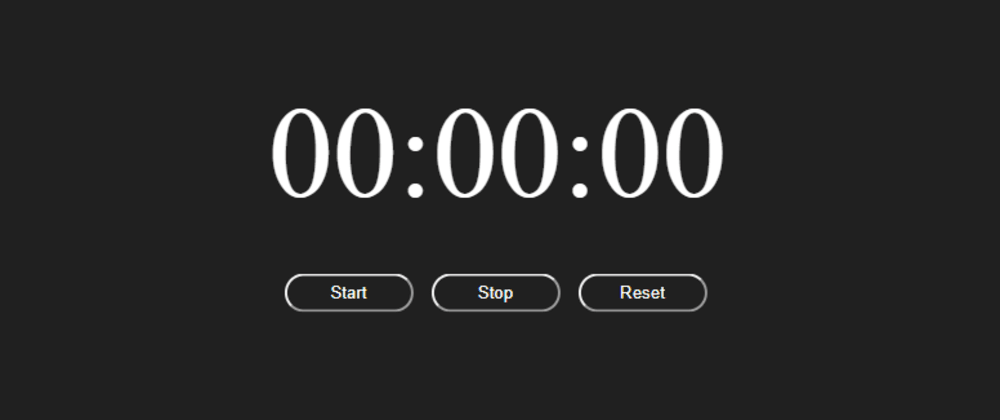Start and Stop Time Tracking Button Javascript

![]()
GSPTeck
Posted on • Updated on
Create a Stopwatch in JavaScript
Creating a timer is a very simple task. We will only be using variables, functions and THAT'S IT!
HTML code:
<html> <head> <title>JavaScript</title> <link rel="stylesheet" href="style.css"> </head> <body> <div id="stopwatch"> 00:00:00 </div> <ul id="buttons"> <li><button onclick="startTimer()">Start</button></li> <li><button onclick="stopTimer()">Stop</button></li> <li><button onclick="resetTimer()">Reset</button></li> </ul> <script src="main.js"></script> </body> </html>
CSS code:
body { background: #202020; color: white; } button { width: 100px; height: 30px; border: 3px soldi white; border-radius: 50px; background: #202020; color: white; cursor: pointer; outline: none; } #stopwatch { font-size: 100px; position: absolute; top: 45%; left: 50%; transform: translate(-50%, -55%); } #buttons { position: absolute; top: 55%; left: 48.4%; transform: translate(-51.6%, -45%); } #buttons li { display: inline; padding-left: 10px; }
JavaScript code:
const timer = document.getElementById('stopwatch'); var hr = 0; var min = 0; var sec = 0; var stoptime = true; function startTimer() { if (stoptime == true) { stoptime = false; timerCycle(); } } function stopTimer() { if (stoptime == false) { stoptime = true; } } function timerCycle() { if (stoptime == false) { sec = parseInt(sec); min = parseInt(min); hr = parseInt(hr); sec = sec + 1; if (sec == 60) { min = min + 1; sec = 0; } if (min == 60) { hr = hr + 1; min = 0; sec = 0; } if (sec < 10 || sec == 0) { sec = '0' + sec; } if (min < 10 || min == 0) { min = '0' + min; } if (hr < 10 || hr == 0) { hr = '0' + hr; } timer.innerHTML = hr + ':' + min + ':' + sec; setTimeout("timerCycle()", 1000); } } function resetTimer() { timer.innerHTML = '00:00:00'; }
Edit:
As pointed out by 'uthx' in the comments we need to add a function to reset the values of sec, min and hr when resetting the time. We can do that by using the following function (function coded by 'uthx'):
function resetTimer() { timer.innerHTML = "00:00:00"; stoptime = true; hr = 0; sec = 0; min = 0; }
Final Result:

(Naturally it works. Tested it myself 😉)
Explanation
Disclaimer! In the code you may notice it's called a 'timer' and not 'stopwatch', that's because 'timer' is shorter than 'stopwatch' and I don't feel like having to type that all the time 😂.
-
const timer = document.getElementById('stopwatch');imports the timer 'div' as a variable, using it's id, so we can modify it as we wish. -
var hr = 0; var min = 0; var sec = 0;we are creating the hour, minute and second variables and we are declaring that their initial value is 0. -
var stoptime = true;we create a variable so we can then verify if the stopwatch is running or not. -
if (stoptime == true) { stoptime = false; timerCycle(); }if the stopwatch is not running, turn it on and go to thetimerCycle()function. (This only runs if we click the 'Start' button) -
if (stoptime == false) { stoptime = true; }if the stopwatch is running, turn it off. (This only runs if we click the 'Stop' button) -
if (stoptime == false) {verify that the stopwatch is on. -
sec = parseInt(sec); min = parseInt(min); hr = parseInt(hr);these are used to parse a string into an integer. (if we have 1045 as a string and we want to use it as an integer, we parse it) -
sec = sec + 1;add 1 to seconds. -
if (sec == 60) {if seconds are equal to 60, minutes = 1 and seconds becomes 0 again. -
if (min == 60) {if minutes are equal to 60, hours = 1 and seconds + minutes becomes 0 again. - Fun part:
if (sec < 10 || sec == 0) { sec = '0' + sec; } if (min < 10 || min == 0) { min = '0' + min; } if (hr < 10 || hr == 0) { hr = '0' + hr; }
If seconds, minutes and/or hours are lower than 10, add a 0 in front. This is why we need to parse everything in the beginning: doing this operation they become strings.
-
timer.innerHTML = hr + ':' + min + ':' + sec;add these values to the 'timer' div. -
setTimeout("timerCycle()", 1000);this will make sure there is a timeout of 1000 ms (1s) before repeating the 'timerCycle()'. -
timer.innerHTML = '00:00:00';used to reset the timer to 00:00:00
AND WE'RE DONE!
Learn how to earn money as a developer HERE.
Start and Stop Time Tracking Button Javascript
Source: https://dev.to/gspteck/create-a-stopwatch-in-javascript-2mak